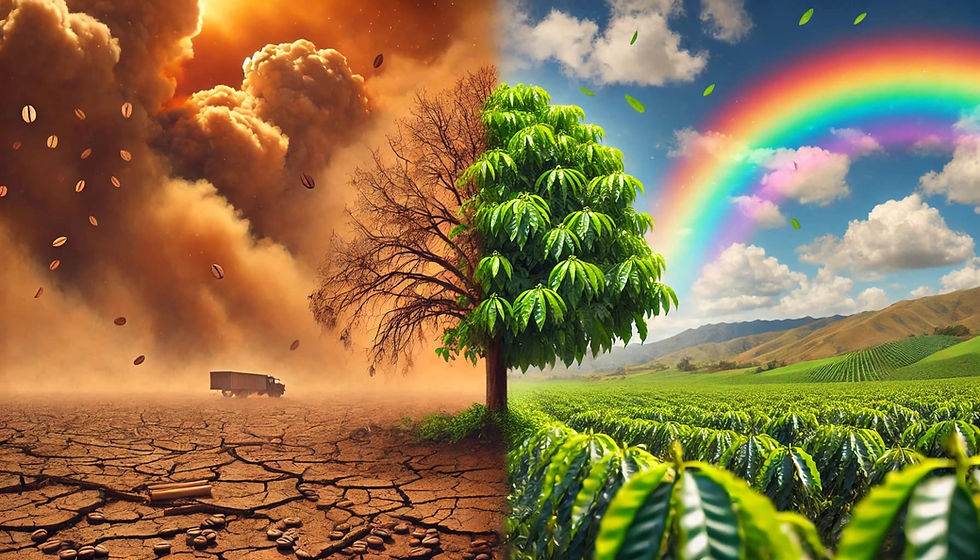| The Impact of Climate on Coffee Flavor and Bean Quality |
- iovn2802

- Jun 20, 2024
- 3 min read
Climate plays a crucial role in determining the flavor and quality of coffee. Factors such as temperature, altitude, rainfall, soil composition, sunlight, and microclimate all interact to influence the development of coffee cherries and the final flavor of the beans.
1. Temperature
High Temperature: Speeds up the ripening of coffee cherries, which can lead to overripe or unevenly ripe beans. This reduces the complexity of the flavor and increases bitterness.
Low Temperature: Slows down the ripening process, allowing beans to develop more sugars and complex flavors, often resulting in a sweeter and more refined cup.
Day-Night Temperature Variation: Large temperature differences between day and night can enhance the coffee's flavor. Cool temperatures at night slow down ripening, helping increase the sugar content in the beans and develop complex flavor compounds.
2. Altitude
High Altitude: Typically associated with cooler temperatures, which slow down the ripening process. Coffee grown at high altitudes often has higher acidity, more complex flavors, and higher bean density. Higher density beans are usually of better quality because they contain more nutrients and flavor compounds.
Low Altitude: Generally warmer, leading to faster ripening and often producing coffee with lower acidity, simpler flavors, and lower bean density.
3. Rainfall
Consistent Rainfall: Ensures a stable growing environment, leading to uniform ripening of coffee cherries, which can improve quality, uniformity, and bean density.
Inconsistent Rainfall: Can stress coffee plants, leading to issues like uneven ripening and increased susceptibility to pests and diseases, negatively affecting flavor and bean density.
Rainfall Requirement: Coffee plants need a certain amount of annual rainfall to grow well.
4. Soil Composition
Nutrient-Rich Soil: Contributes to the healthy growth of coffee plants and cherries, resulting in beans with richer and more complex flavors and higher density.
Poor Quality Soil: Can lead to deficiencies in coffee plants, affecting their growth and the quality of the beans, including their density.
Ideal Soil Characteristics: Deep, well-aerated, well-drained soil with a neutral to slightly acidic pH. The soil should be rich in nitrogen, phosphorus, and potassium, with a high humus content in the top layer.
5. Sunlight
Sunlight Requirement: Coffee plants need about 4-6 hours of direct sunlight per day to grow best. Sunlight helps the plants photosynthesize, develop sugars in the cherries, and create more complex flavors. Planting shade trees among coffee plants also helps regulate the amount of sunlight, protect the plants from excessive sun, and reduce the risk of leaf burn. Shade trees can also protect coffee plants from frost at night and provide additional income from other crops such as bananas, grapefruits, or avocados.
6. Microclimate
The specific climatic conditions of a coffee-growing area, including temperature, humidity, and wind patterns, can create unique flavors in coffee beans. For example, coffee from regions with cool nights and warm days often has prominent acidity, vibrant flavors, and higher bean density.
Natural Farming: Many farmers are adopting natural farming methods, integrating coffee plants into local forests to protect them from climate change and excessive sunlight. Shade trees and larger plants help protect coffee plants from wind and erosion and provide natural fertilizer from fallen leaves.
Climate directly impacts the flavor, quality, and density of coffee beans. Factors such as temperature, altitude, rainfall, soil composition, and sunlight all interact to affect the development of coffee cherries. Higher density beans are often associated with better quality because they contain more nutrients and flavor compounds. Understanding and meeting the specific needs of each coffee variety can help farmers achieve optimal yield and quality, producing delicious and rich-flavored coffee.
References:
- "Coffee: Growing, Processing, Sustainable Production" - Jean Nicolas Wintgens, Wiley-VCH, 2004.
- "The World Atlas of Coffee: From Beans to Brewing" - James Hoffmann, Mitchell Beazley, 2014.





Comments